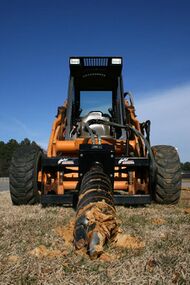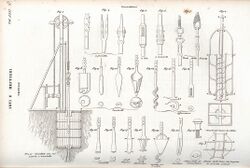Engineering:Auger (drill)

An auger is a drilling device, or drill bit, used for making holes in wood or in the ground.[1] It usually includes a rotating helical screw blade called a 'flighting' to act as a screw conveyor to remove the drilled out material. The rotation of the blade causes the material to move out of the hole being drilled.
Types
An auger used for digging post holes is called an earth auger, handheld power earth drill, soil auger, or mechanized post hole digger. This kind of auger can be a manually turned, handheld device, or powered by an electric motor or internal-combustion engine, possibly attached to a tractor (being provided with power by the tractor engine's power take-off as shown). Handheld augers can also be used for making holes for garden planting.[citation needed]
Wood augers have a screw to pull them into the wood, as a gimlet has, and a cutting lip that slices out the bottom of the hole. The auger bit, meant to be used in a brace, also has cutting spurs to cut a clean circle deeper than where the lips scrape out the wood.[2]
In construction, augers are used for special drilling rigs to dig holes, or augerating for deep foundation piles. Another use is for piles forming a piling retaining wall, which can be constructed in the same way as foundation piles.[citation needed]
Augers – either gas- or hand-powered – are used by ice fishermen to drill holes to fish through. Drilling into maple trees to extract maple syrup is also carried out with the use of augers.[3]
Gallery
See also
- Augerino
References
- ↑ "auger". ldoceonline. https://www.ldoceonline.com/dictionary/auger.
- ↑ Cox, George William (1906). The little cyclopaedia of common things (12th ed.). S. Sonnenschein & Co.. p. 31. https://books.google.com/books?id=JUnOAAAAMAAJ&pg=PA3.
- ↑ Ciesla, William M. (2002). Non-wood forest products from temperate broad-leaved trees. Food and Agriculture Organization of the United Nations. p. 37. ISBN 92-5-104855-X.
External links
- "Brief history of the auger". Wonkeedonkeetools. https://www.wonkeedonkeetools.co.uk/auger-bits/a-brief-history-of-auger-bits.





